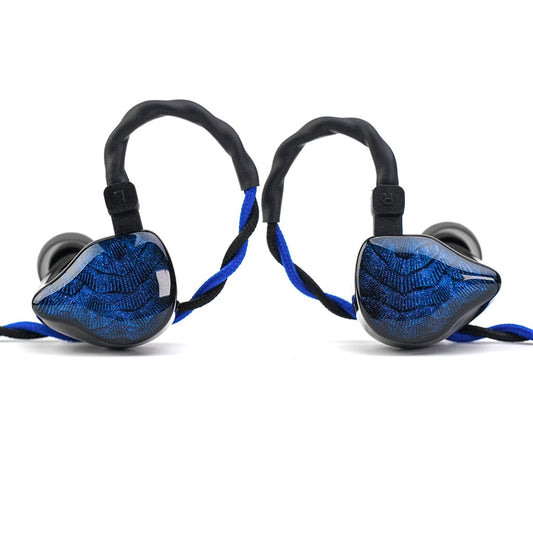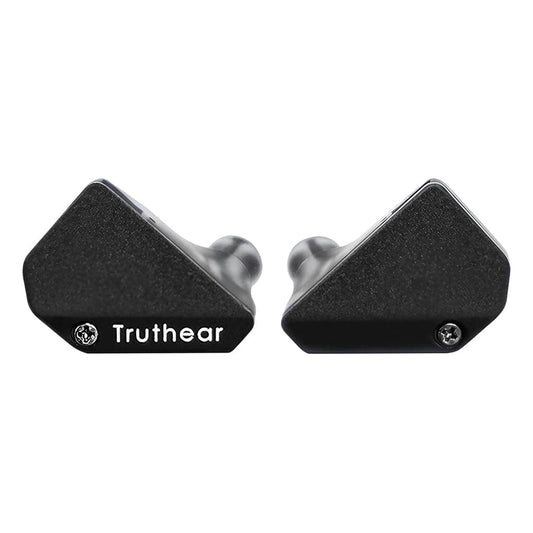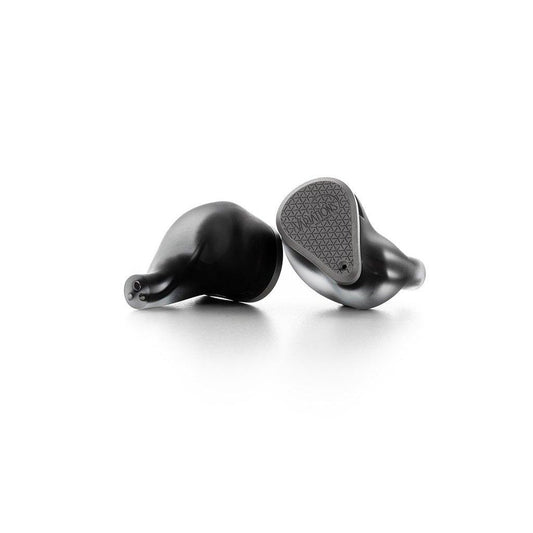Truthear Nova: On a Theme
Nova’s release was met with some pretty massive hype due to it being Truthear’s first product over $100. But does the Nova actually improve upon its predecessors enough to command a price roughly double that the Hexa?
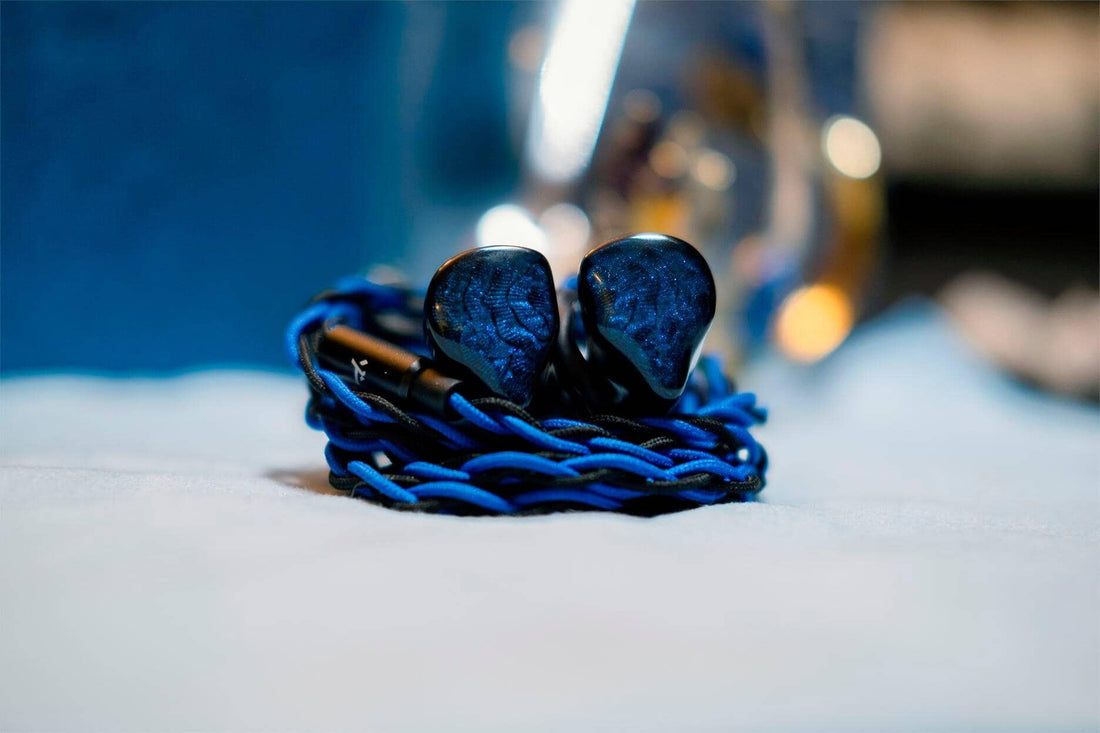
Introduction
The Nova is the latest in a series of IEMs released by Truthear, a brand that came out of nowhere in 2022, only to dominate the IEM discourse in 2023. Truthear has so thoroughly commanded the conversation that other brands that used to be fixtures of the discussion have seemingly had trouble remaining relevant.
Whether it be their $20 Hola, $55 Truthear Zero: RED, or $80 Hexa, Truthear has firmly cemented themselves (to me, at least) as the current kings of the budget IEM sphere. These offerings have all but replaced the comparable products like the Salnotes Zero or Moondrop Aria on my personal recommendation list.
Due to this near-unilateral dominance of the budget range, the news of the Nova’s release was met with some pretty massive hype—compounded more by the fact that it was Truthear’s first product over $100, and early measurements suggested certain features that would make it unique in that price range.
But now that I have it in for testing (many thanks to Precogvision for sending this out for review), does the Nova actually improve upon its predecessors enough to command a price roughly double that the Hexa? Let’s find out.
What we like
- Bass is a focus, good size and punch
- Channel balance is exceptional
- Treble is remarkably smooth-measuring…
What we don’t like
Accessories
With the Nova, we get a fairly unique complement of tips. We receive silicone narrow-bore tips, foam tips, as well as 2 sizes/colors of bi-flange tips. Full disclosure, all impressions in this review are made with the silicone tips, as I wasn’t given foam tips, and the flange tips nullified one of the supposed core benefits of Nova’s performance—the “smooth” treble.
We get a compact, egg-shaped carrying pouch with a belt clip, which I prefer to the “fold-up” case included with the Zero: RED and Hexa. It feels much more sturdy, and feels more intended for actual on-the-go use thanks to the clip.
The included cable is a mixed bag. It’s lightweight, which is great, but it’s also extremely prone to tangling in my brief experience with it. Even when roadie-wrapped, I still find pulling the cable out of the included carrying case to be a chore almost every time. However, once it’s unwrapped, plugged in, and in my ears, I actually quite like its ergonomics.
Overall nothing groundbreaking here, with my main complaint that bi-flange tips aren’t really useful at all as they make the treble noticeably bad sounding (I would’ve preferred wide bore silicone tips). Otherwise, Nova earns a lukewarm passing grade.
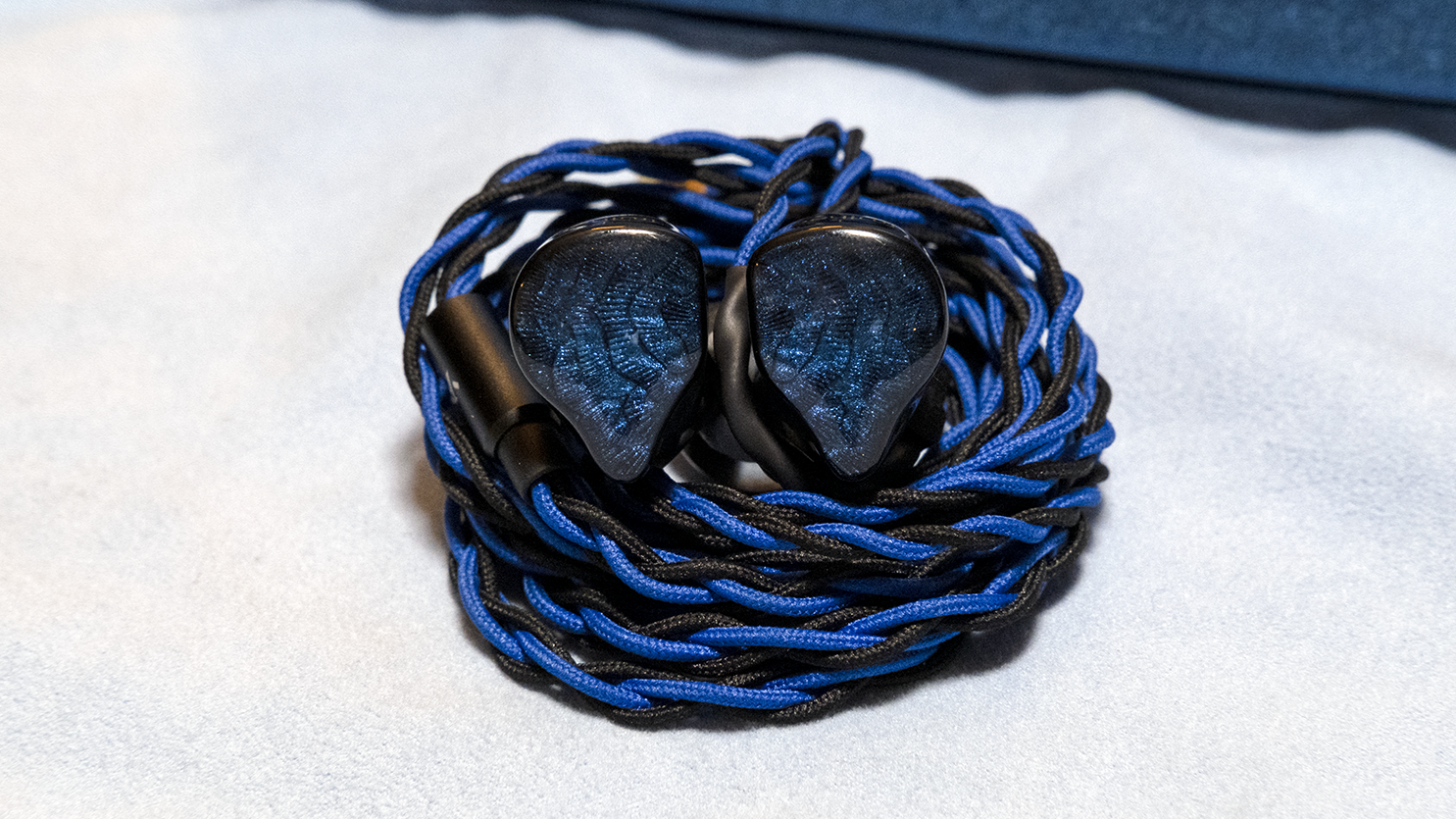
Ergonomics
This is where a lot of people have had complaints about Truthear’s product lineup before, and unfortunately I’m not sure Nova does quite enough to escape the reputation Truthear has garnered thus far.
As far as positives go, Nova definitely has one of the best nozzle profiles of Truthear’s lineup so far. It’s thinner at the tip than the Zero: RED and Hexa, while being long enough to accommodate a variety of ear canal entrance types and tips. It also has a subtle, but defined lip in the middle of the stem to prevent tips from falling off. Simply put, the nozzle isn’t the aspect I’d see people having issues with.
The thing listeners will likely have gripes about is actually the shell size/shape. Nova is easily Truthear’s biggest shell so far, so listeners with smaller outer ears may still find fit to be troublesome. Personally, I find this to be a common problem with IEMs writ large, and since Nova bucks zero trends, I have to dock a few points for that.
Even if it’s not an outright bad IEM for comfort, I confess I was really hoping they improved on this more since they’d had no shortage of feedback from customers on their other products. Though the nozzle is perfectly comfy for me, the shell size makes ingress to/egress from my ear clunky and hard to find an ideal spot with.
Frequency Response
Above is a graph of the Truthear Nova measured on the B&K Type 5128-B, compensated to the rig’s Diffuse Field HRTF. The bounds behind the measurement are the bounds of preference outlined in the existing speaker and headphone literature.
Below is perhaps a more familiar view to many people; Truthear Nova measured on my IEC 60318-4 clone coupler, placed against Harman’s 2019 IEM Target.
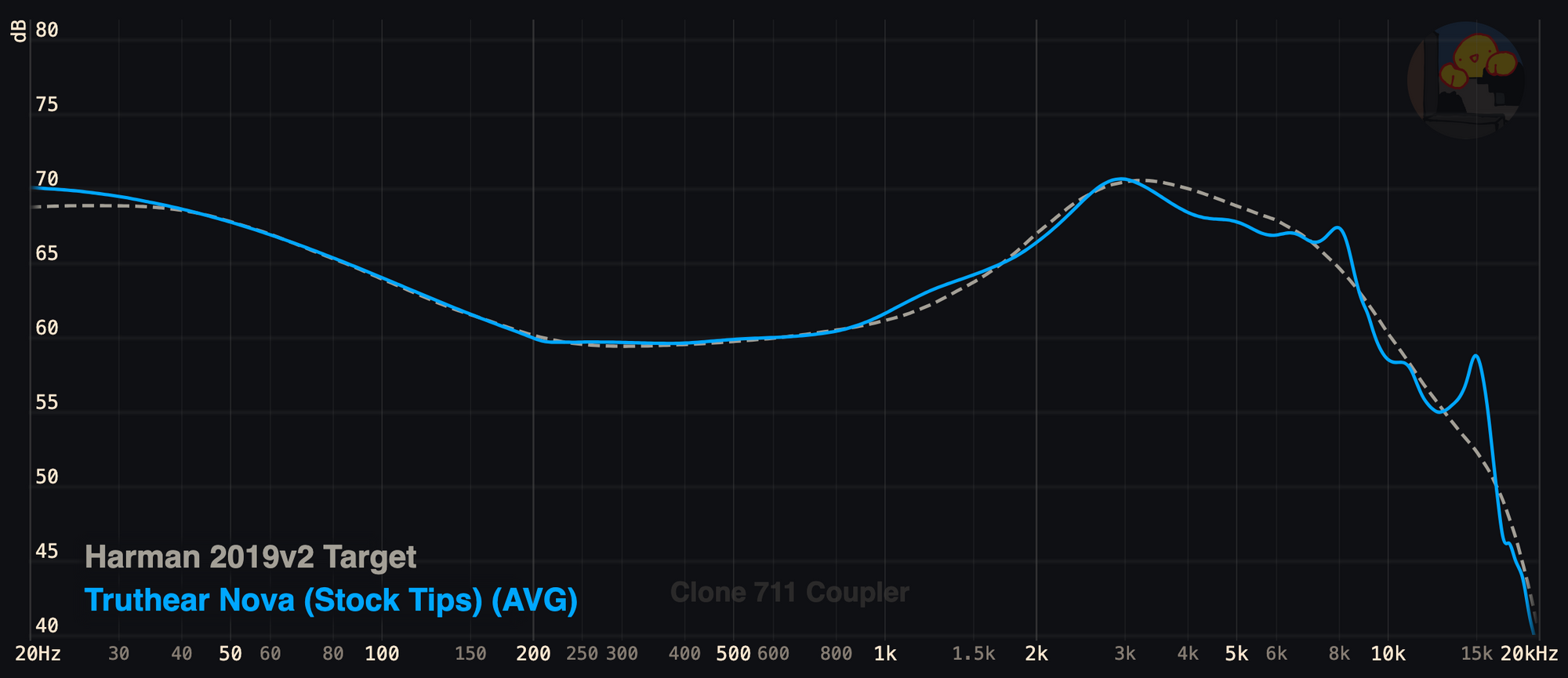
Oh boy.
Yet another Harman-tuned IEM.
I have to be fully transparent about my preferences and how they bias me here: I am absolutely sick of this approach to frequency response tuning. There are plenty of reviewers out there that can jive with this kind of tuning (most notably, Crinacle, who has the Moondrop Variations ranked at “S tier” for its tuning), but I am not one of them. Adherence to Harman’s IE curve has historically been a near-guarantee that I wouldn’t like an IEM’s tonality.
To go a step further, this tuning choice prevents Nova from standing out even in Truthear’s own catalog, where the Zero lineup already offers two marginally different (and some might even say better) versions of this sound.
So even though most of us are probably already familiar in some sense with how a Harman-tuned IEM probably sounds, let’s go ahead and unpack it.
Bass
There’s plenty of sub-bass emphasis and extension for the rumble of 808s or subharmonic synths to come across as fully represented. Kick drums sound supernaturally big and have enough resonance to feel like they have ample decay down low. However enjoyable it is at first, it quickly becomes clear that it’s a super fun, albeit noticeably unrealistic bass presentation.
That being said, I rather enjoy how the shape of the elevation gives a little bit more love to sub-bass than mid-bass, as this helps bass guitars sound less uneven as they move from low notes to higher notes and the shape of the balance between fundamental and overtone shifts slightly.
Harman’s shelf location has always made intuitive sense to me, and frankly I think very few people will have gripes with the bass in isolation. Nova sports a engaging, bass-emphasized sound that brings the size, weight, and “slam” that I gather both audiophiles and everyday-consumers will enjoy. Unfortunately though, this is where the praise ends.
Midrange
The midrange of the Nova is chiefly defined by a cavernous suckout in the low-midrange. This is unfortunately very audible and colors basically every instrument or voice on any recording I listened to.
Snare drums sound like they’re made out of tissue paper, guitars are artificially sharp, harsh and strident, and almost every vocalist sounds both super-clenched and nasally.
The contrast between low-midrange and bass makes Nova sound a bit like a cheap, poorly integrated 2.1 setup that you’d get at Staples in the mid-2000s. Bass instruments are big but poorly integrated with the rest of the response, as they have the bulbous Harman shelf bringing the fundamentals forward, but virtually no supporting breadth in their first few overtones.
The upper midrange is actually fairly well-tuned in isolation, having a very “HRTF-y” shape to its ascent to the 3kHz ear gain peak. But there’s just too much distance between this area and the low-midrange, causing an imbalance favoring harmonics over fundamentals that’s pretty hard to ignore.
Nearly everything sounds translucent, bereft of any note weight or realism. Additionally, Nova easily earns the unfortunate descriptor of “shouty,” as there were more than a few times I had to listen quieter than I would like just to save myself from wincing at the sheer distance between the 3kHz ear gain peak and the low-midrange recession.
The midrange on the Nova is hard enough to live with that it literally made writing this review take longer. I simply couldn’t listen to it for more than a few minutes at a time without getting upset and either having to remove them to take a break, or having to reach for my EQ. If you came here wondering about the mids, I’ll say it right now: look elsewhere unless you really, really like a thin midrange.
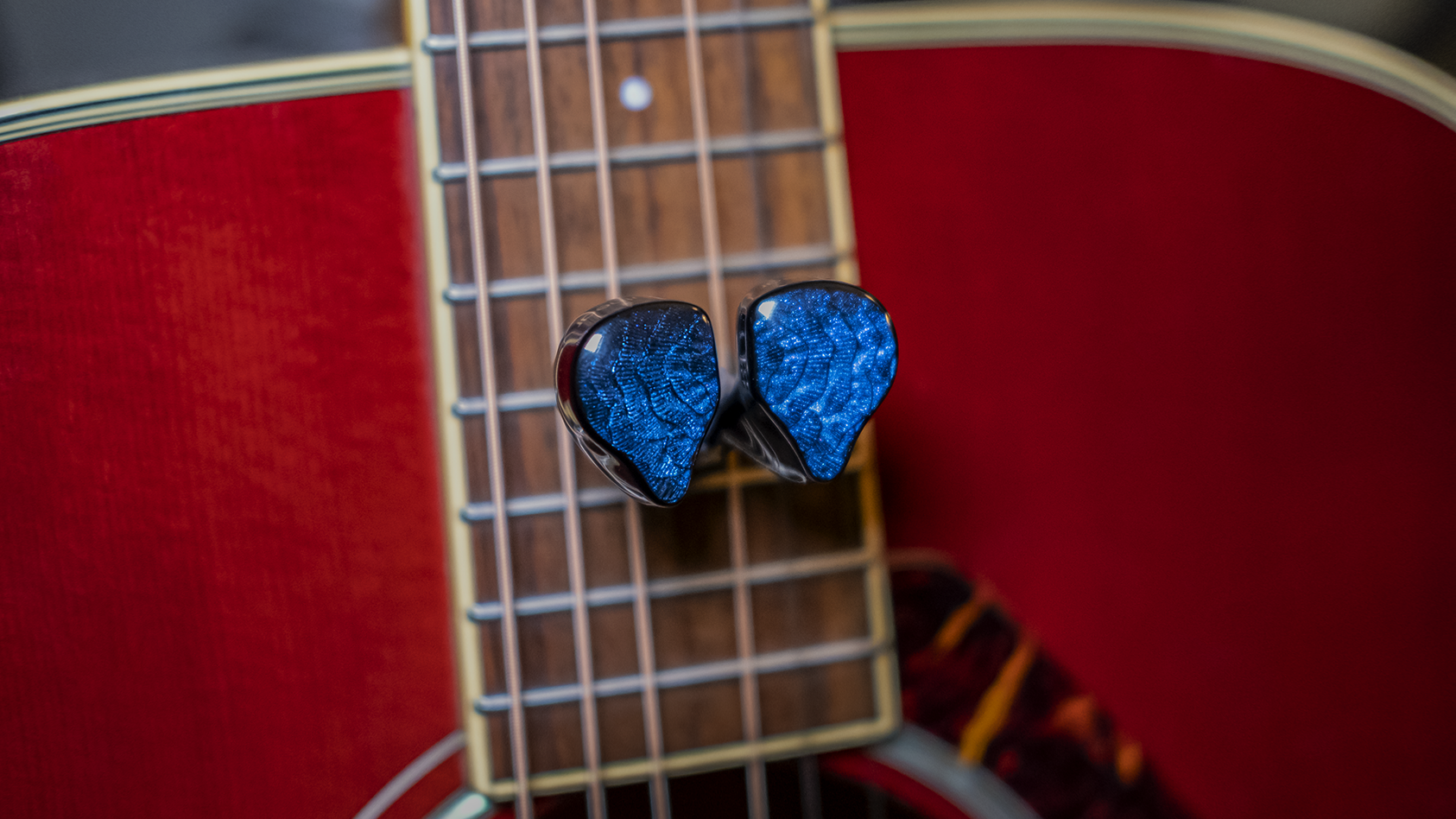
Treble
This is the part of Nova that I was hyped for, but I fear I’m disappointed here too. The measurements indicated Nova might actually be one of the best options for treble in IEMs at any price, but after living with it for a bit, I don’t think that’s true. At least not in stock formation.
While Nova is very smoothly elevated and would likely sound “minimally peaky” to many people, it’s still decisively elevated above what I’d call neutral, and elevates in a way that actually makes it harsher than the measurements may suggest at first blush.
Nova’s treble has a rough, somewhat sandy character that I’d attribute mostly to what sounds like a wide-band elevation between 4-8kHz. Vocalists in particular sound very raspy and breathy in a way that makes them unpleasant to listen to for more than a few minutes. Electric guitars almost sound like the pickups are microphonic, and they’re picking up unwanted resonances from the vibration of the bridge. Virtually every drum I heard on Nova sounded like the skins were made of dollar store toilet paper.
I’m usually more tolerant of elevations here vs. mid-treble or upper treble elevations, and Nova does deserve a bit of credit for it’s smooth response above 8kHz… but when compounded with its already incredibly wimpy midrange, Nova is to me a wholly thin and glarey listen, just with a big bass boost tacked on.
This I think could be due to a few things on Truthear’s part. If Truthear is aiming for the DF HRTF of the B&K 5128 as a target, even with a preference tilt, this was actually bound to happen. It could also be that they’re just trying to eat Moondrop’s lunch by offering a cheaper alternative to the Variations, but we’ll touch on that later.
There hasn’t been much discussion about the former point in many reviews, and I’ve only touched on it briefly prior, but there’s a fair amount of evidence that the pinna (outer ear) of the B&K 5128 is on the brighter side vs. the average human. This is made clear when comparing the DF HRTF of the 5128 to an average of human DF HRTFs.
So if we wanted a target for IEMs, it’s probably best to subtract the contributions of the 5128’s outer ear and substitute that with contributions from human outer ears. More info on this can be found in my article The Shape of IEMs to Come, but the TL;DR is that adhering to a target strictly based on the 5128 DF in the treble may not actually be a good thing for IEMs measured on this system, as it’s likely too bright of a baseline compared to humans (even when tilted). Unfortunately, Nova adheres to this potentially flawed target very well.
Wrapping up the tonality section, I gotta say I’m not at all surprised I don’t like Nova’s frequency response. As stated prior, I’m usually averse to Harman-type tunings, but I still thought I’d like the treble more. What we’re given with Nova is something that at first glance may look smooth on a frequency response measurement, but in my listening it simply didn’t sound all that smooth.
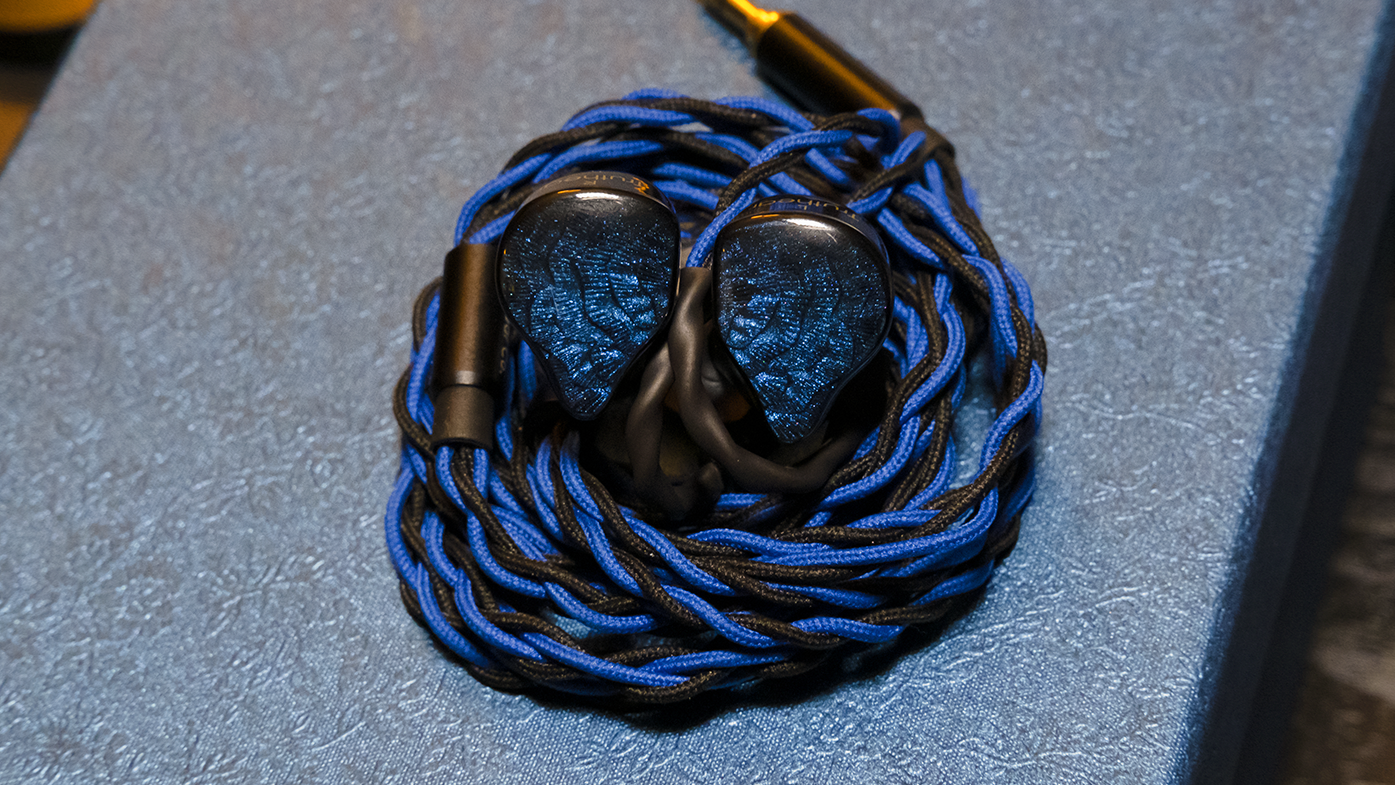
Technicalities
This is where Nova starts to gain a little bit of ground back for me. While I find Nova’s tonality almost entirely off-putting, there are some benefits to harnessing a tuning that harnesses large, contrasting swings in SPL between areas of the frequency response.
The contrast present in Nova’s signature seems to have a positive effect on the sense of contrast in SPL (dynamics)… or, at least it does in the bass. Nova is easily the heaviest hitter when it comes to punch and slam that I’ve experienced in this price range, beating even Moondrop’s Blessing 3 for this quality. Kick drums especially are preternaturally large, heavy and concrete, propelling and supporting the whole of the mix in a way that makes other Truthear offerings like the Zero: RED seem flat and uninteresting by comparison.
Unfortunately when it comes to dynamics in the areas other than bass, I don’t have as much praise for Nova. I noticed the range between prominent elements in the front-center of the mix (eg. vocals) and background elements like keys, pads, and drums sounding eerily close in volume and almost like they were blurring together, making it hard to parse which was meant to truly be “in front”.
Because of this, it sounds like everything is constantly fighting for your attention, but the bass is the only thing engaging enough to both properly command your attention and reward said attention.
The sense of lateral separation however, is quite good on Nova. Things panned to the sides don’t blur into each other quite as much as the sounds in the center do, and there’s a good sense of panoramic width to the stage. The downside is that the stage simultaneously sounds rather incoherent. The lower-midrange is thrown to be notably more distant than the upper mids and treble, so you get all of the buzzy, gnashing overtones very close to your face, but all of the fundamentals and warmth that would usually cue an intimate, close presentation are sent the opposite way. In a word: Nova sounds confused.
In terms of “detail” or other terms associated with that sense of being able to pick up smaller cues in your music, I actually found Nova to be quite good. This is likely due to its treble and upper-midrange being so much more forward than the lower-midrange. At the cost of a perhaps unnatural frequency response, you get extra texture on guitars, extra spittle and breath on vocalists, and extra audibility of your reverb tails. Not worth it at all to me, but I guess it could be to some listeners.
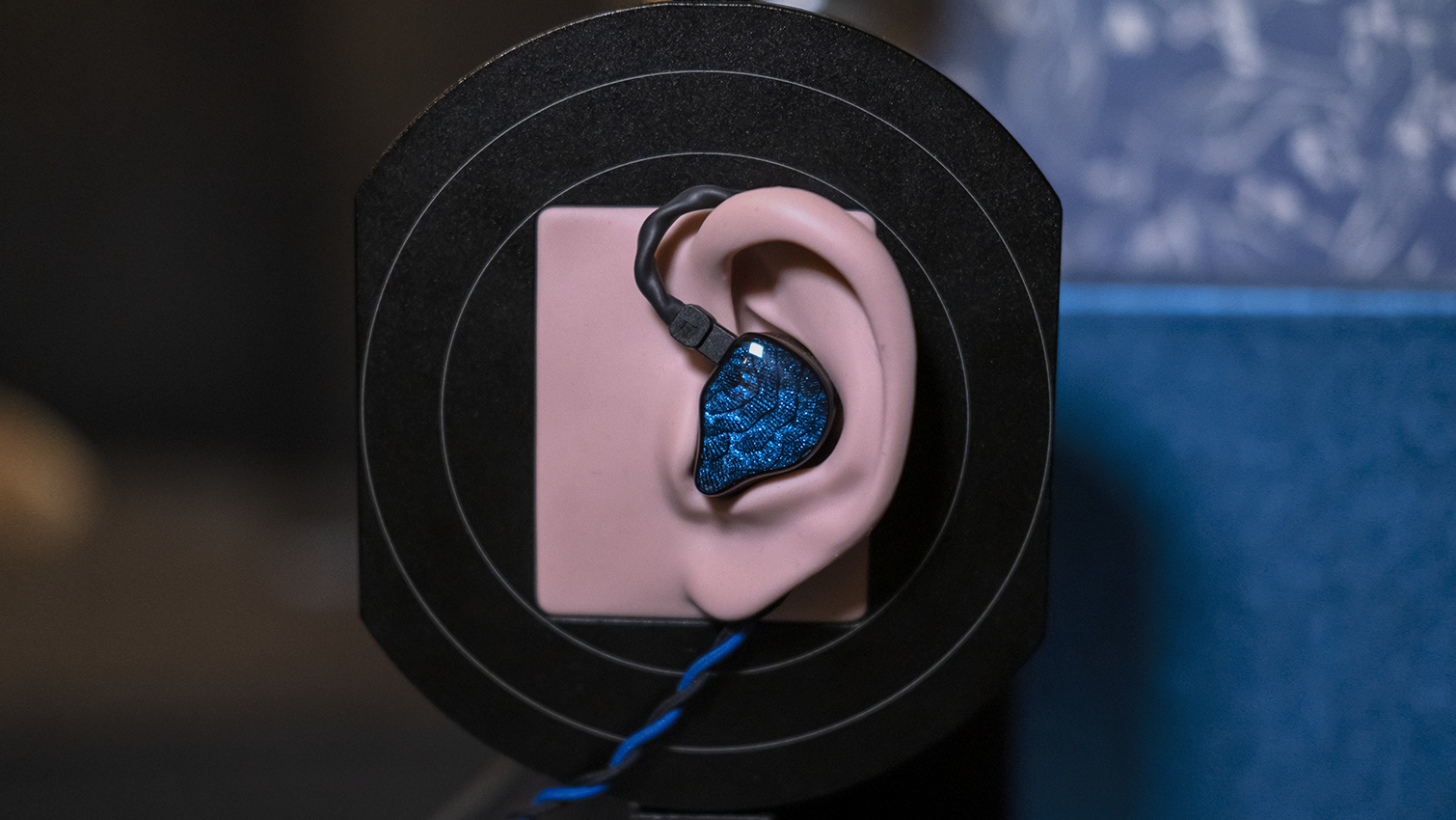
EQ
I don’t love the idea of reviewing an IEM with EQ, so I’m not gonna sit here and say Nova’s prowess with EQ automatically makes it worth the price. It doesn’t.
However, I did find Nova to be one of the easier IEMs to EQ out of the ones I’ve tried. Really all one needs (for palatability, not perfection) is a single peak filter around 300Hz with a Q of .5, and the listener can decide how many decibels of “fill” in the low-midrange is required to offset the precipitous dip that Nova has there. Additionally, if one wanted to curtail a bit more of Nova’s intensity, a 5500Hz peak filter with a Q of 2 helps to reign in some of the paperiness I’ve mentioned.
It’s worth saying though, the idea of something being “great with EQ” is not a superlative I’m particularly happy with. Pretty much anything, barring truly horrid cases, can be made to sound pretty darn good with EQ.
And to me, who is probably one of the most “EQ-happy” enthusiasts out there, I cannot stress how much I hate having to pull up an EQ just to make something not bother me. So something being “easy to EQ” seems like a distinction without a real difference: if I have to pull out the EQ, I’m not happy with the product.
It doesn’t make sense to me to praise an IEM for being easier to EQ than another, even if the Nova in this case was indeed rather easy to EQ. All IEMs can be EQed, but I’d rather not have to do it at all, and manufacturers should be tuning their IEMs better.
But if you’re like me, and are already equipped to use & benefit from EQ, Nova is likely an excellent choice for that. It may even be the best choice for EQ currently on the market in terms of value proposition... But I still don’t think it excuses Nova’s flaws at all.
If you’d like an additional perspective on this, check out Resolve’s review on our YouTube channel, where he goes into more detail as to why IEMs in particular might necessitate EQ more than headphones.
Comparisons

vs. Truthear Zero: RED
Before Nova was announced, I was hoping that Truthear’s next IEM would be a more ergonomic take on the treble found in the Zero: RED, with the midrange tilted more towards warmth in the low-midrange like the Hexa.
What I got was not that.
Zero: RED actually beats Nova almost across the board in tuning for me. It simply sounds more (but still not perfectly) normal. Kick drums are still prominent, but don’t sound as unrealistically hyped. Snare drums sound less papery, though not perfect. Guitars are more balanced and less harsh, and vocals are no longer overwhelmingly thin, breathy, or grating.
If their goal was to provide something more technical, I think that’s fair, as the bass of Nova is easily more dynamic than Zero: RED, and Nova’s presentation is overall much more “vivid.” But these are literally the only places it clearly beats RED. In every other sonic regard, I would still probably take RED.
On the bright side, I can say with near-certainty that Nova is the more ergonomic IEM, as the Zero: RED is particularly poor in this regard. However, it’s my view that Nova is a decisive step backward in tuning for Truthear. And I’m not just saying that to be dramatic either.
We all remember Truthear’s first IEM, the Zero, was tuned to Harman’s In Ear curve. Then we got the Zero: RED, which was Crinacle planting the flag saying “I think people will prefer this to the original Zero” and providing something tuned closer to his IEF Neutral 2020 curve instead.
There were problems with that experiment, sure, but I have no idea, after Truthear went through all of the trouble of having their “Harman vs. IEF” battle, why they thought releasing yet another Harman-tuned IEM was a good idea.
Nova is already close enough to the original Zero that it should likely be considered equal value-per-dollar sonically, but since I preferred RED to the original Zero, it should be no surprise that I prefer RED to the Nova as well. Not off to a good start.
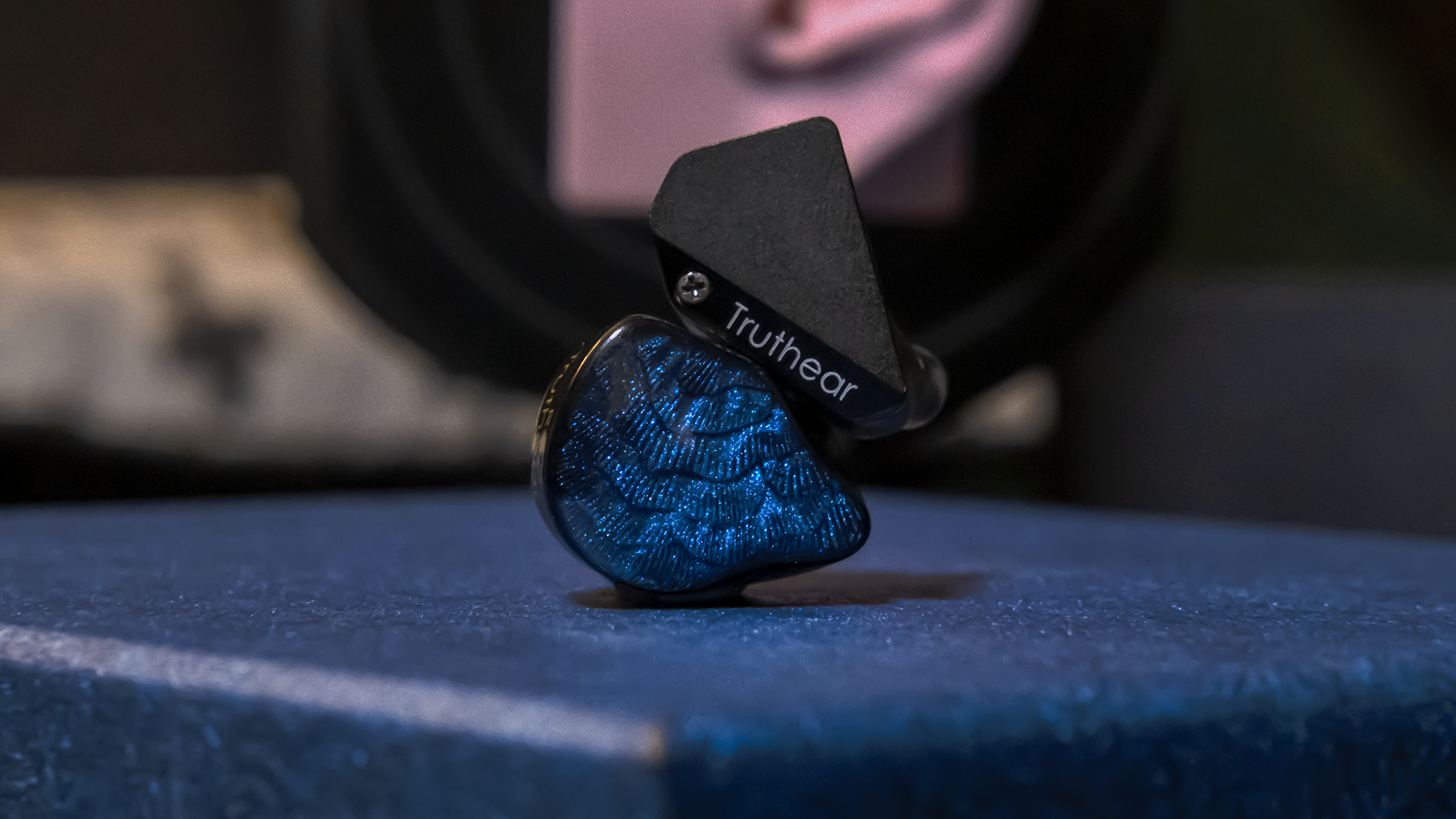
vs. Truthear Hexa
Putting in the Hexa after listening to the Nova makes it more clear how big a step backwards the latter really is.
I will say, the Nova easily has a smoother treble presentation than Hexa, has more dynamic bass, and is more ergonomic in my ears (both in terms of nozzle, as well as shell shape). But that’s where Nova’s benefits end.
Hexa has one of the best midranges in this price tier full-stop, being one of the only IEMs under $100 that can actually come close to producing convincing vocal intimacy and richness. The Nova, by contrast, sounds like vocalists are singing into a megaphone.
Hexa’s portrayal of the drum kit is much more honest, with kick drums sounding less like it overshadows the whole mix and more like a heartbeat-like thud, subtly but surely holding down the forward momentum of the mix underneath everything else. The same can be said for the snare drum, which finally gets some love given to its fundamentals, enough to actually make it sound like a snare drum instead of the grainy mess that Nova serves.
Thanks to the lower treble being more relaxed on Hexa, the breath and lispiness of vocals and the rattle and buzz of guitars are much less oppressively close and the stage as a whole is much more natural in terms of where instruments are placed relative to each other in a front-to-back sense.
Hexa is still Truthear’s best current-production IEM (rest in peace, Hola) but I wish they would just make a version of Hexa with the treble smoothness of the Nova, as it would be one of the best IEMs on the market.
But they didn’t, so Nova should just be regarded as a slightly smoother and more ergonomic version of the original Zero (even though that’s already what the Zero: RED was). By contrast, Hexa should be regarded as the most “normal” sounding of Truthear’s lineup, and is probably still the IEM I’d recommend to someone under $150 or so.
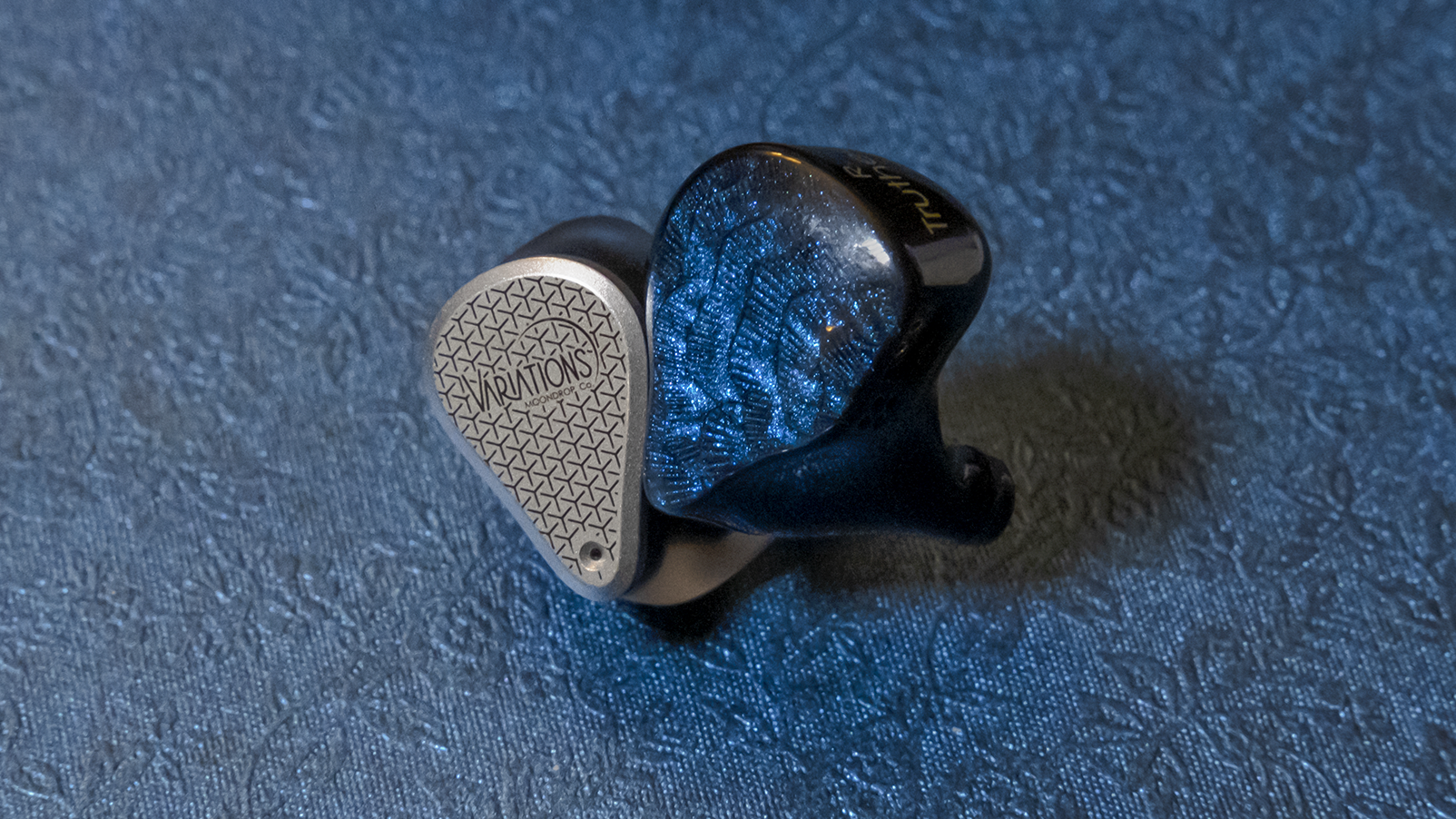
vs. Moondrop Variations
The measurement shown above is of a different Variations unit than the one I am evaluating here, measured by Resolve on the B&K Type 5128-B HATS.
Below is the Moondrop Variations I have in for review, measured on my IEC60318-4 clone coupler, compared to Nova and Harman’s 2019 IE target. Full disclosure, the Variations unit I have on hand is probably the best measuring pair I’ve seen, with significantly more low-midrange and less treble than the others I’ve seen.
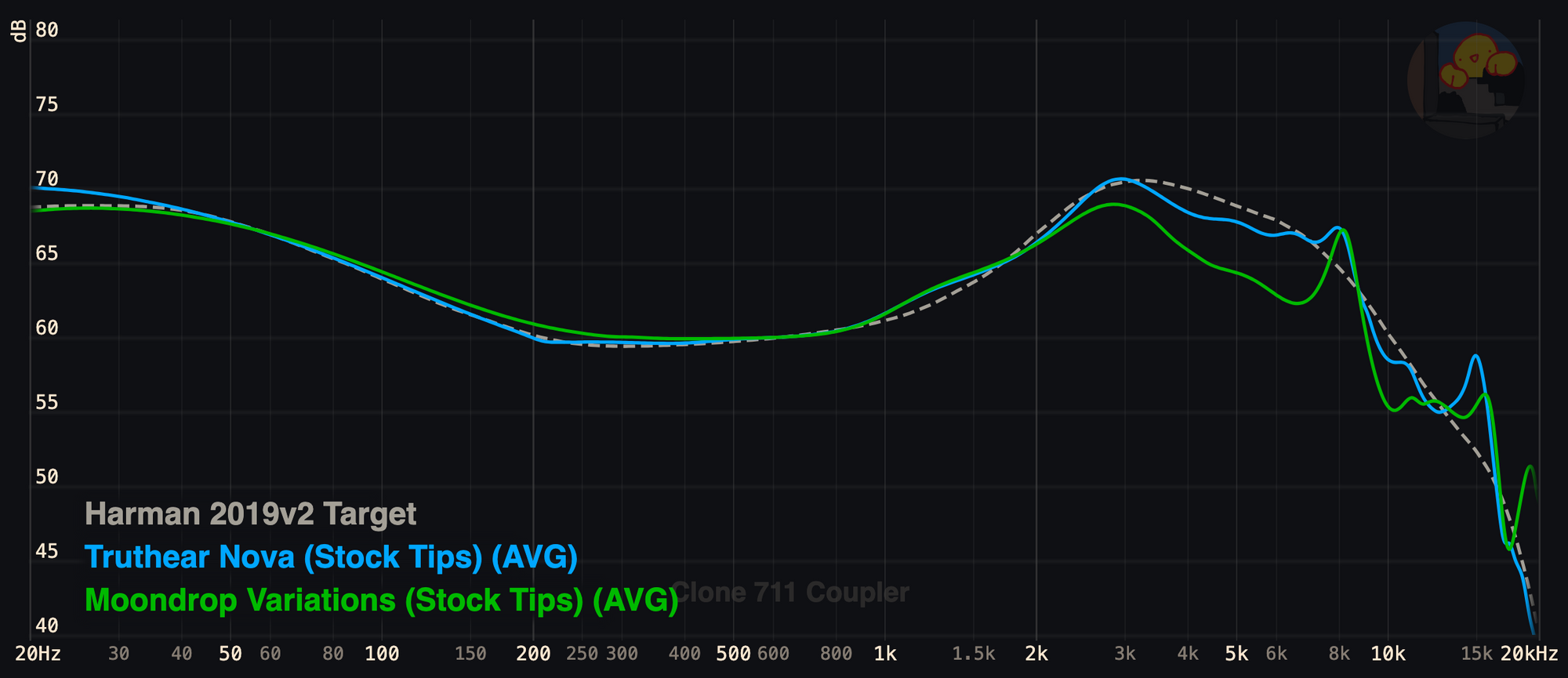
This is the comparison I wager most people are gonna be interested in, and for good reason. They (typically) measure very similarly, and they even use what seem to be the exact same eartips… but Nova is significantly cheaper.
And good news, I think most people’s assumptions about them being close is accurate, for the most part. Both have a cloyingly thin midrange response, with comparatively gargantuan bass presentation, and a mostly-smooth treble response.
However, since I can only judge the two units I have on hand as they are, I have to say that the Variations unit I have is meaningfully more refined in the treble. Where the Nova sounds breathy, grainy, and harsh due to the interaction between the thin low midrange and boosted low treble, Variations is much more subjectively smooth and relaxed between 3-8kHz, which helps the overall response sound much less grating. But it doesn’t fix the cavernously dipped low midrange, or the resulting bass incoherence.
I find the Variations to be more comfortable and have a better package of accessories (though I still don’t really like it's cable) and I actually prefer the look of the Variations too, as Nova’s faceplate is probably my least favorite of Truthear’s so far.
Interestingly, when it comes to technical performance, I actually think I prefer Nova’s approach to bass and dynamics. Variations is rather smoothed and wispy sounding, where Nova sounds a bit more hard-edged, solid and tactile. In terms of things like “detail”, that’s gonna depend on the listener. I hear them as being equally lacking in the things I care about (dynamics, timbre) while being similar in most other aspects.
All in all, both Nova and Variations are close enough—especially if most Variations units measure like the others I’ve seen, which measure almost identically to Nova—that you should probably just save money and go for Nova if you’re in the market for a Harman-tuned IEM. But to be extra clear, I’m definitely not in the market. I don’t really like either of these IEMs.
But if you want a Harman-tuned IEM, there are still cheaper options for that kind of sound signature (like Truthear’s own Zero series), if you’re willing to sacrifice a little bit in terms of ergonomics or treble smoothness. Otherwise, Nova is probably the Harman IEM worth looking into if you want specifically that sound, as Variations is simply too expensive in my opinion for the sound it offers.
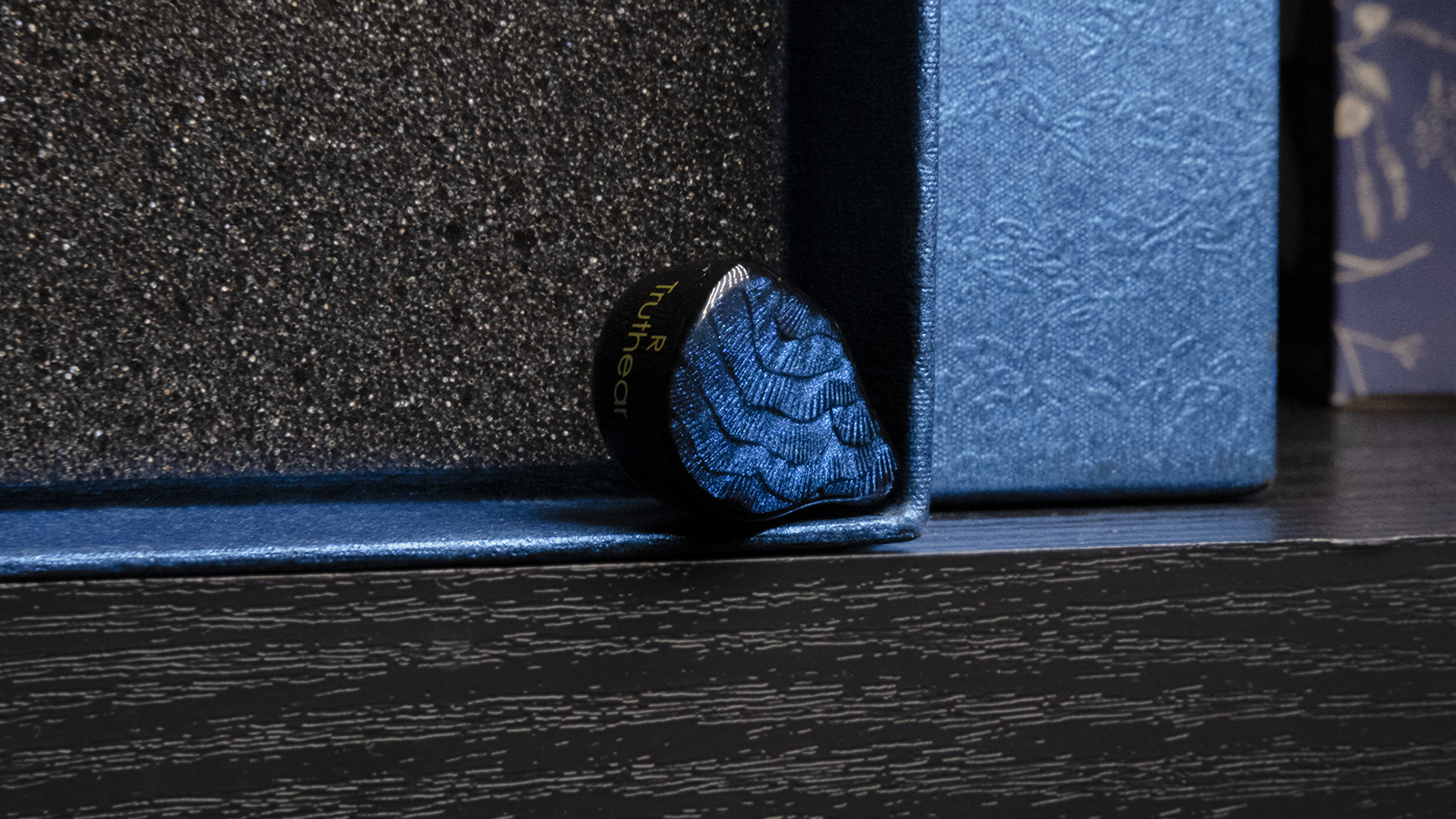
Conclusion
Gotta be blunt here. In a market where every brand already has their take on Harman, I cannot overstate my disappointment that Truthear—a brand arguably at the forefront of IEM tuning at every price bracket they occupy—opted to tune their newest, most expensive product to the same target that a ton of things are already tuned to (including one or two of their own products).
It could be true that Truthear really is just gunning for Moondrop specifically, and this rumor has made the rounds for a while. Truthear’s Hola was basically the IEM that made Moondrop’s Aria irrelevant, and many called Hexa the “budget Blessing 2”. It’s possible that Truthear’s goal with Nova truly was just to eat into Moondrop Variations’s market share. If that was the goal, I guess they’ve succeeded, as they’ve gotten close enough to make Variation’s value proposition much less compelling now.
But honestly, I just don’t see the point.
I don’t know why they didn’t try to combine the best parts of their two best products—Hexa’s midrange and lower treble with Zero: RED’s bass and upper treble. They had a chance to fill a gaping hole in the market, but instead chose to compete with a bunch of other IEMs that do roughly the same thing… one or two of them being less expensive offerings in their own catalog.
Harman-ish IEMs have been coming out like clockwork for the past 2 or 3 years, and every time another one comes, a section or two of the community revs up the hype train yet again. But if there’s one thing connecting most IEM enthusiasts in the spaces I’m in? People are bored as hell.
If Truthear wants to get a rise out of people, it’s my view that they’re gonna have to get creative and actually offer something we haven’t seen before… and Nova is the definition of “something we’ve seen before.”
Unfortunately, Nova is the least impressive, least unique, and least “worth the price” of any of Truthear’s IEMs thus far. The only thing I can truly say it achieves is being a cheaper version of an IEM I don’t like very much.
However, If you really like the Harman IE target, Nova is probably as safe a choice as any of the other Harman stuff out there. So while I can’t say I don’t recommend it at all… I don’t recommend it decisively over any of the other ones, especially not the ones that are less expensive.
Past that, if it were me I’d probably still just buy RED or Hexa, and wait for IEM manufacturers to get the memo that people are tired of variations on a theme.
Thanks so much for reading. If you have any questions about this article, feel free to start a discussion on our forum below or ping me in our Discord channel, which is where you can find me and a bunch of other headphone and IEM enthusiasts hanging out talking about a whole buncha stuff. Until next time!
